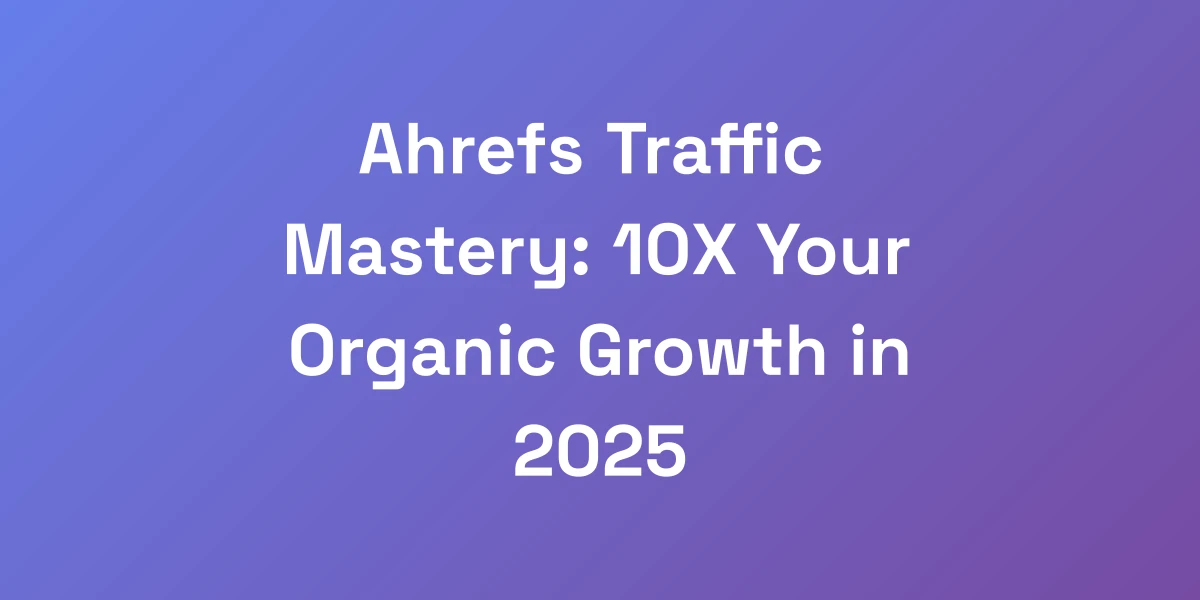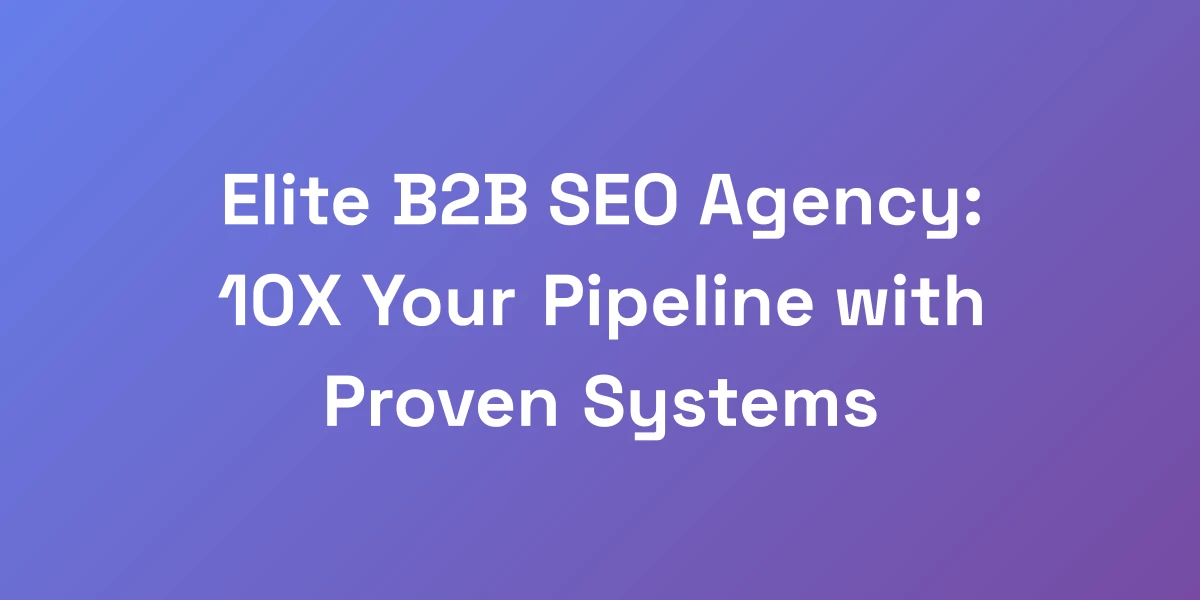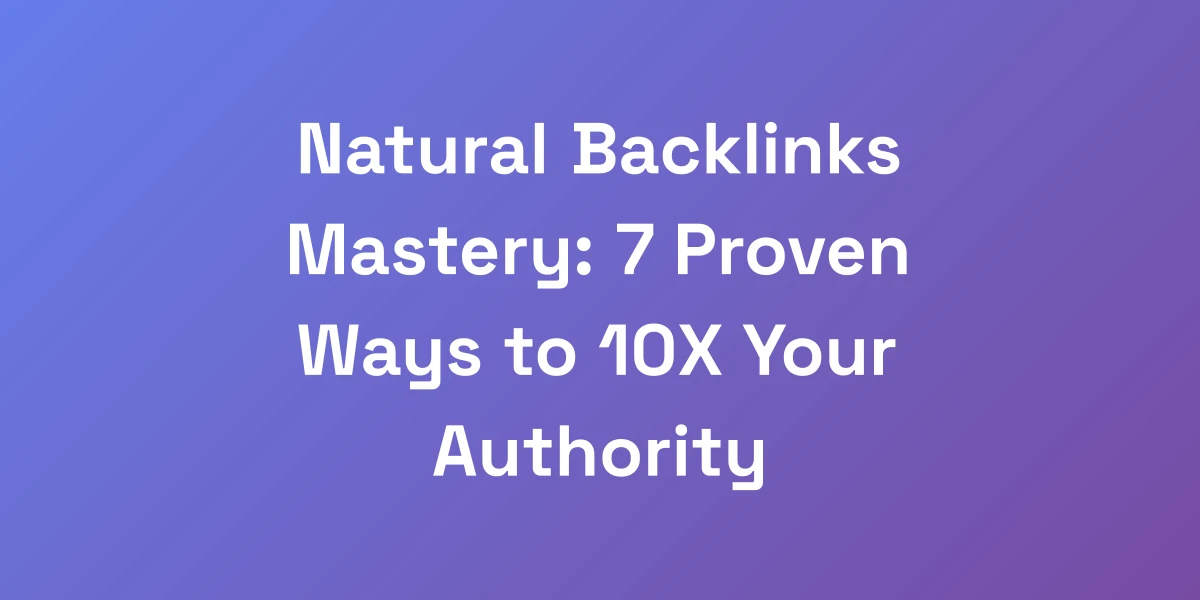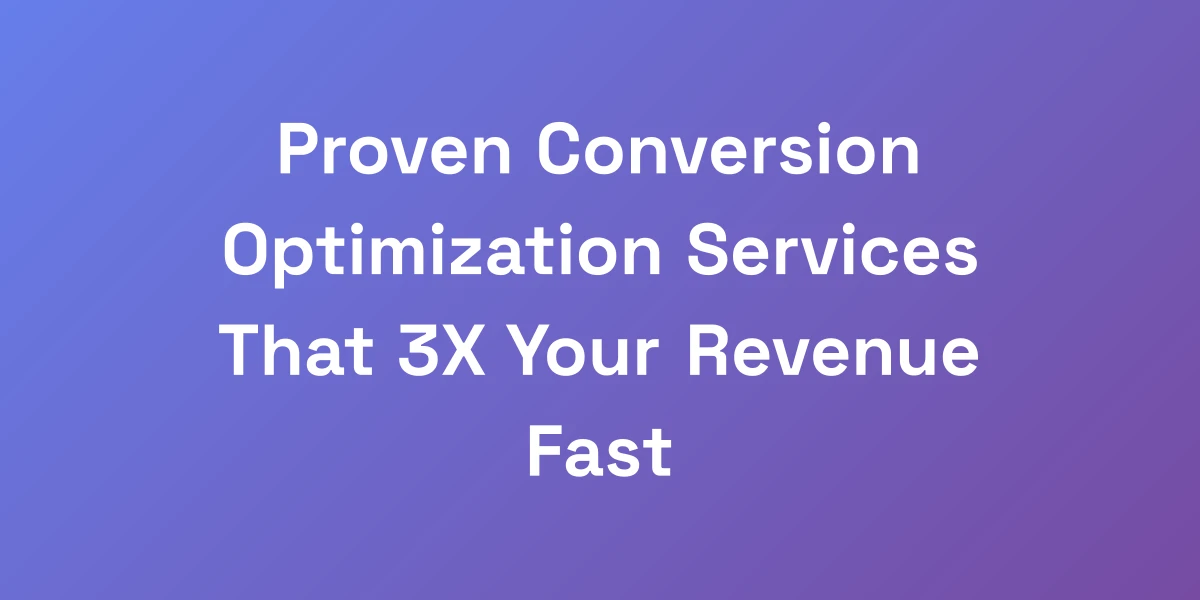
Ahrefs Long Tail Keywords: 5X Your Traffic With This Proven System
Apr 4, 2025 | By [email protected]
The $100K Traffic Secret: Why Long Tail Keywords Are Your Untapped Gold Mine
Let us hit you with some truth: you’re leaving money on the table if you’re not leveraging long tail keywords. We’ve built multiple 7-figure businesses by targeting these hidden gem keywords that your competitors are too lazy to find.
Here’s the reality – while everyone fights over the same expensive, high-competition keywords, smart operators are quietly dominating their niches with long tail keywords that convert like crazy.
Imagine tapping into a gold mine so rich that others haven’t even heard of it. That’s exactly what long tail keywords offer. We’re about to unveil how you can find and exploit these opportunities using Ahrefs, the same tool we’ve used to generate millions in revenue.
The Psychology Behind Why Long Tail Keywords Convert Better
Why do long tail keywords outperform their short counterparts? It all boils down to intent. When someone types a long tail keyword, they’re usually further along in the buying journey.
Think about it – a user searching for “best ergonomic office chair for back pain” is likely ready to purchase, compared to someone searching for just “office chair.” The specificity indicates a clear intent, leading to higher conversion rates.
- Specificity: Long tail keywords are detailed, capturing precise user needs.
- Lower Competition: Fewer websites target these phrases, increasing your chances of ranking.
- Higher Relevance: Content tailored to these keywords meets exact user expectations.
By understanding the psychology behind these searches, we can craft targeted content that resonates deeply with our audience, driving not just traffic, but valuable conversions.
Breaking Down the ROI: Long Tail vs Short Tail Keywords
Let’s talk numbers. Long tail keywords often deliver a higher ROI compared to short tail keywords. Why? Because they attract a more targeted audience.
For instance, our analysis shows that long-tail keywords convert at a rate of about 36%, while even the best landing pages for short-tail keywords convert at around 11.45%. That’s more than three times the effectiveness.
- Cost-Effectiveness: Lower competition means cheaper PPC costs.
- Higher Conversion Rates: Specific intent leads to more qualified leads.
- Scalability: Easier to scale with multiple niche keywords.
Investing in long tail keywords is like planting seeds in fertile soil – the returns are bountiful and sustained over time.
The 80/20 Rule of Keyword Selection
Ever heard of the Pareto Principle? It states that 80% of your results come from 20% of your efforts. This applies perfectly to keyword selection.
By focusing on the 20% of long tail keywords that drive 80% of your traffic, you maximize efficiency. These are the keywords that are not only searched frequently but also lead to high conversions.
- Identify High-Impact Keywords: Use Ahrefs to find keywords with a balance of search volume and low competition.
- Prioritize Content Creation: Focus on creating quality content around these high-impact keywords.
- Monitor and Optimize: Continuously track performance and refine your strategy.
By concentrating on the right keywords, we ensure that our efforts yield the highest possible returns. For a comprehensive guide on SEO for 2024 using long tail keywords, refer to our extended resources.
Why Your Competitors Are Missing These Opportunities
Most businesses are stuck in the short tail keyword race, overlooking the treasure trove of long tail keywords. Why? They’re focused on high competition, expensive keywords, missing out on the gems that are easier to rank for and more profitable.
We’ve seen competitors neglect these opportunities, allowing us to dominate niches with precision. By leveraging Ahrefs, we uncover these hidden gems that others overlook, giving us a significant advantage in traffic and conversions.
- Less Saturation: Fewer competitors targeting specific phrases.
- More Niche Traffic: Attracting users with specific needs increases engagement.
- Higher Loyalty: Targeted content fosters a deeper connection with your audience.
Don’t let your competitors steal your spotlight. By tapping into long tail keywords, you can carve out your own space in the market.
Real Numbers: Conversion Rates Comparison
Let’s get down to the stats. Long-tail keywords shine when it comes to conversion rates. On average, they convert at about 36%, compared to the 11.45% conversion rate for short-tail keywords.
Take Healthline, for example. By targeting specific health-related queries, they’ve managed to rank for thousands of long-tail keywords, generating substantial organic traffic. This strategic approach not only boosts traffic but significantly enhances conversion rates.
- Healthline’s Success: Leveraging long-tail keywords to dominate health niches.
- Higher Engagement: Specific queries match user intent, increasing interaction.
- Enhanced Authority: Comprehensive content around long-tail keywords builds trust.
These numbers don’t lie. Long tail keywords are a powerhouse for driving profitable traffic.
The Perfect Long Tail Keyword Formula Using Ahrefs
Stop wasting time with guesswork. We’re about to give you the exact formula to find long tail keywords that actually make money. Using Ahrefs’ Keywords Explorer, we’re going to implement a systematic approach that’s proven to identify keywords with high commercial intent and low competition.
This isn’t theory – it’s a battle-tested framework that’s generated millions in revenue across multiple industries. The key? Knowing exactly which metrics matter and which are just vanity numbers. For a visual walkthrough, check out our YouTube video tutorial.
Setting Up Your Ahrefs Keywords Explorer for Maximum Results
First things first, setting up Ahrefs correctly is crucial. Here’s how we tailor our Keywords Explorer for optimal performance.
- Define Your Seed Keywords: Start with broad terms related to your niche.
- Select the Right Metrics: Focus on Keyword Difficulty, Search Volume, and Click Potential.
- Utilize Filters: Use Ahrefs site audit Page Explorer advanced filters to narrow down to the most promising long-tail keywords.
By configuring Ahrefs this way, we streamline the keyword discovery process, making it efficient and effective.
The Critical Metrics That Actually Matter
Not all metrics are created equal. Here’s what we focus on:
- Search Volume: Indicates the number of searches per month. Look for moderate volumes – enough to drive traffic but not too competitive.
- Keyword Difficulty: Measures how hard it is to rank. We aim for keywords with a difficulty score below 30.
- Click Potential: Evaluates the likelihood of clicks. High click potential ensures that your efforts translate into actual visits.
These metrics help us filter out the noise and focus on keywords that can deliver real results.
My 3-Filter System for Finding Winners
We use a three-step filter system to identify winning keywords:
- Relevance: Ensure the keyword aligns with your business offerings and audience needs.
- Search Volume: Target keywords with enough searches to warrant targeting.
- Competition: Prioritize keywords with lower competition to maximize ranking potential.
This triage ensures we only invest our time in keywords that can drive significant traffic and conversions.
Commercial Intent Indicators to Look For
Not all traffic is created equal. We focus on keywords that signal strong commercial intent:
- Transactional Keywords: Phrases like “buy,” “purchase,” or “discount” indicate readiness to convert.
- Review Keywords: Terms such as “best,” “top,” or “reviews” suggest comparison shopping.
- Local Keywords: Adding location-based terms targets users ready to act locally.
By honing in on these indicators, we ensure our efforts are directed toward users with high conversion potential.
The Competition Analysis Framework
Understanding your competition is essential. Here’s how we analyze them:
- Identify Top Competitors: Use Ahrefs to see who ranks for your target keywords.
- Analyze Their Content: Examine the quality, depth, and structure of their content.
- Assess Their Backlinks: Determine how they’re obtaining their domain authority.
Armed with this information, we can strategize to outperform them by offering superior content and leveraging unique opportunities.
Advanced Long Tail Keyword Strategies That 99% Don’t Know
Here’s where we separate the amateurs from the professionals. Most people stop at basic keyword research, but we’re about to dive into advanced tactics that virtually guarantee results.
We’ve used these strategies to build and sell multiple businesses, and they work across any niche. The key? Leveraging Ahrefs’ advanced features to uncover hidden opportunities your competitors can’t see. For example, industry-specific approaches like Hotel SEO Mastery, Plumbers SEO, and Lawyer SEO Companies can further enhance your strategy.
The Parent Topic Strategy
Instead of targeting isolated keywords, we focus on entire parent topics. This approach helps in creating comprehensive content clusters that search engines love.
- Identify Core Topics: Use Ahrefs to find broad themes relevant to your niche.
- Generate Subtopics: Break down these core topics into specific long-tail keywords.
- Create Content Clusters: Develop interconnected content around these subtopics to enhance authority and relevance.
This strategy not only boosts SEO but also establishes your site as a go-to resource for comprehensive information.
Question-Based Keyword Mining
People often search in the form of questions. By targeting these, we capture highly engaged traffic ready to convert.
- Use Ahrefs Question Feature: Identify common questions within your niche.
- Create Answer-Focused Content: Develop detailed, informative content that directly answers these questions.
- Optimize for Voice Search: Ensure your content is tailored for conversational queries.
By addressing these specific queries, we attract users seeking precise information, leading to higher satisfaction and conversion rates. For more insights, explore our long-tailed keywords tool guide.
The Competitor Gap Analysis Method
Find gaps in your competitors’ strategies and exploit them to your advantage.
- Identify Underserved Keywords: Use Ahrefs to spot keywords your competitors haven’t targeted effectively.
- Develop Unique Content: Create content that fills these gaps with superior quality and depth.
- Leverage Low Competition: Focus on these less competitive keywords to gain quicker rankings.
This method ensures you’re tapping into areas with high potential but low competition, maximizing your traffic growth.
Using SERP Features to Your Advantage
Search Engine Results Pages (SERPs) are packed with features that we can leverage for better visibility.
- Featured Snippets: Optimize content to appear in snippet boxes by answering questions concisely.
- People Also Ask: Target these questions with additional content to capture more SERP real estate.
- Local Packs: For local businesses, ensure your content is optimized for local search features.
By understanding and utilizing these SERP features, we enhance our chances of capturing top positions and driving more traffic.
The Content Cluster Approach
Organize your content into clusters around central topics. This not only improves SEO but also provides a better user experience.
- Create Pillar Content: Develop comprehensive guides on main topics.
- Interlink Cluster Content: Link related articles to your pillar content for better navigation and SEO benefits.
- Consistently Update: Keep your clusters updated with the latest information and trends.
This approach helps search engines understand the structure of your site, boosting your rankings and authority.
Implementation: Turning Keywords Into Cash Flow
Knowledge without action is worthless. We’re going to show you exactly how to take these long tail keywords and turn them into actual revenue.
This isn’t about creating content for the sake of content – it’s about building strategic assets that generate consistent traffic and conversions. We’ve used this exact system to build multiple 7-figure businesses, and it’s all about executing with precision and purpose.
Content Architecture That Converts
Effective content architecture is the backbone of a successful SEO strategy.
- Organize Content Logically: Ensure your website structure makes sense, with clear pathways to related content.
- Use Clear Hierarchies: Implement a hierarchy that allows search engines and users to navigate easily.
- Optimize for User Experience: Prioritize mobile responsiveness, fast loading times, and intuitive navigation.
A well-structured site not only improves SEO but also enhances user engagement, driving better conversions.
The Perfect Content Structure
Crafting the perfect content structure is key to maximizing SEO benefits.
- Engaging Headlines: Use compelling headlines that incorporate your long tail keywords.
- Subheadings for Clarity: Break down content with H2 and H3 subheadings for better readability.
- Multimedia Integration: Enhance your content with images, videos, and infographics to keep users engaged.
A clear and engaging structure ensures that your content is both user-friendly and search engine optimized.
Optimization Techniques That Move the Needle
Optimizing your content is not a one-time task. We employ several techniques to ensure our content remains ahead of the curve.
- On-Page SEO: Optimize meta titles, descriptions, and headers with target keywords.
- Internal Linking: Link to other relevant content on your site to boost SEO and user engagement.
- Schema Markup: Implement structured data to help search engines understand your content better.
These optimization techniques ensure that your content is easily discoverable and ranks well in search results.
Tracking and Measuring Success
Tracking performance is crucial to understanding what works and what doesn’t.
- Use Ahrefs Analytics: Monitor keyword rankings, traffic, and backlinks to assess performance.
- Set Up Goals: Define clear goals such as conversions, sign-ups, or sales to measure success.
- Regular Audits: Conduct regular SEO audits to identify and fix issues that may hinder performance.
By consistently tracking and measuring your efforts, you can make informed decisions and refine your strategy for optimal results.
Scaling Your Long Tail Strategy
Once you’ve established a successful long tail keyword strategy, it’s time to scale.
- Expand Keyword Research: Continuously seek out new long tail keywords to target.
- Automate Processes: Use tools and software to streamline your keyword research and content creation.
- Outsource Content Creation: Delegate content production to focus on strategy and scaling efforts.
Scaling effectively ensures that your traffic continues to grow, driving more revenue and solidifying your market position.
Common Pitfalls and How to Avoid Them
Let’s talk about the mistakes that kill most people’s keyword strategies. We’ve made every mistake in the book, and we’ve spent millions testing what works and what doesn’t.
These are the exact pitfalls that keep most businesses stuck in mediocrity, and we’re going to show you how to avoid them. This isn’t theory – these are real problems we’ve solved across multiple businesses.
The Volume Trap
Focusing solely on search volume can lead you astray. High-volume keywords often come with stiff competition, making them harder to rank for.
- Balance Volume with Intent: Prioritize keywords that not only have decent volume but also strong commercial intent.
- Look for Niche Markets: Target smaller niches with high intent rather than broad markets with generic terms.
- Use Ahrefs Filters: Narrow down keywords by balancing search volume and competition levels.
By avoiding the volume trap, you can focus on keywords that truly drive profitable traffic.
Avoiding Analysis Paralysis
It’s easy to get overwhelmed with data and end up doing nothing. Here’s how to stay focused:
- Set Clear Goals: Define what you want to achieve with your keyword strategy.
- Prioritize Actionable Insights: Focus on metrics that directly impact your goals.
- Limit Your Tools: Use Ahrefs effectively without getting bogged down by every feature available.
By maintaining clarity and focus, you can make decisive moves that drive results without getting stuck in endless analysis.
Managing Keyword Cannibalization
Keyword cannibalization occurs when multiple pages target the same keyword, diluting your SEO efforts.
- Audit Your Content: Regularly check for overlapping keywords across your site.
- Consolidate Content: Merge similar pages to create a single, authoritative piece.
- Assign Unique Keywords: Ensure each page targets a distinct keyword to avoid overlap.
Proper management prevents cannibalization, ensuring each piece of content works towards boosting your SEO effectively.
Content Quality vs. Quantity
Chasing quantity over quality can sabotage your SEO efforts. Here’s why quality matters:
- Engagement: High-quality content keeps users engaged and reduces bounce rates.
- Authority: Well-researched, detailed content builds your site’s authority.
- Rankings: Search engines prioritize content that provides genuine value to users.
Rather than flooding your site with mediocre content, focus on creating exceptional pieces that stand out and provide real value.
When to Pivot Your Strategy
Knowing when to change course is crucial for sustained success.
- Monitor Performance: Regularly review your keyword rankings and traffic metrics.
- Stay Updated: Keep abreast of the latest SEO trends and algorithm updates.
- Adapt Quickly: Be prepared to adjust your strategy based on performance data and industry changes.
Flexibility ensures that your strategy remains effective and responsive to the dynamic SEO landscape.
Conclusion
We’ve walked you through the compelling reasons why long tail keywords are essential for skyrocketing your traffic and conversions. By harnessing the power of Ahrefs and implementing our proven system, you can unlock a treasure trove of opportunities that your competitors are missing.
Remember, it’s not about chasing every keyword but strategically targeting those with high intent and low competition. This approach not only drives targeted traffic but also ensures higher conversion rates, maximizing your ROI.
Ready to take your SEO strategy to the next level? Start implementing these tactics today and watch your traffic multiply. Have any questions or success stories to share? Drop them in the comments below – we’d love to hear from you!








